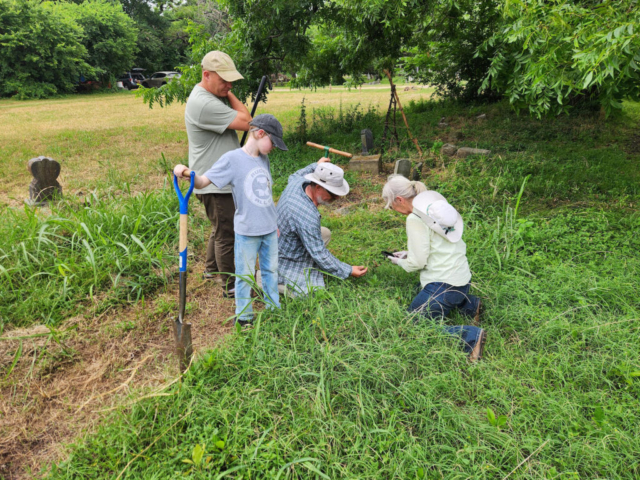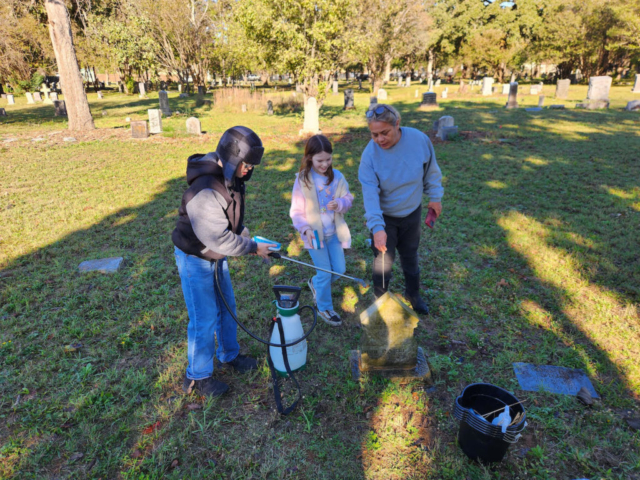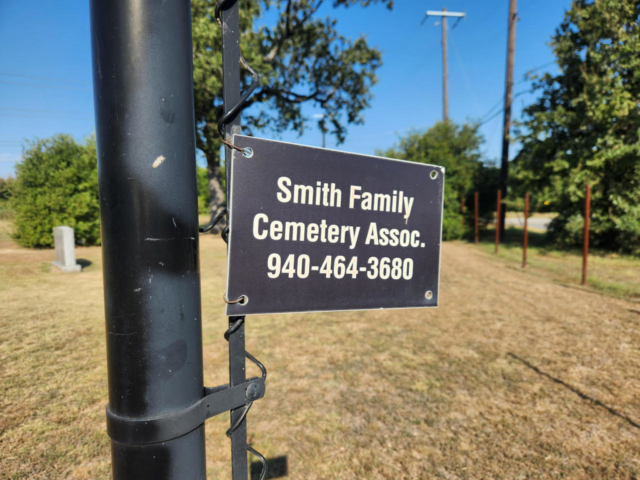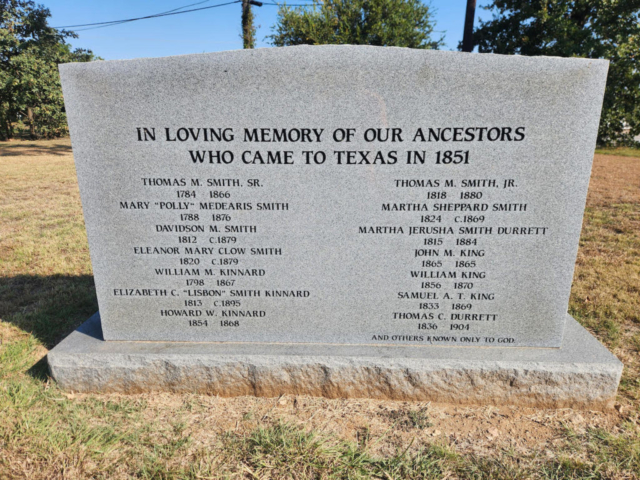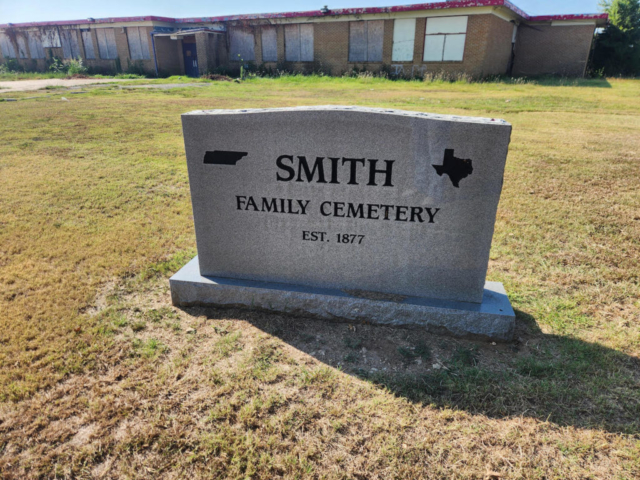By Frances James (1922 – 2019)
After the railroads came to Dallas in 1872-73, the population rapidly expanded and by 1887, the four separate downtown cemeteries, the Masonic, the Odd Fellows, the Jewish and the City Cemetery, now known as Pioneer Cemetery were running out of space. George Loudermilk, an entrepreneur, along with other citizens was making arrangements to purchase land in the area south of the city for a new cemetery providing perpetual care. Most of the other cemeteries in the county did not provide perpetual care and were eyesores most of the time.
The fifty-one acres of land this group eventually purchased for Oakland Cemetery located at 3900 Malcolm X, formerly Oakland Avenue, was a portion of the over 4400 acres of the league and labor known as the Thomas Lagow League. Thomas Lagow, had come to Texas in 1833 with the Reverend Daniel Parker, and had received bounty land from the Republic of Texas for his participation in the War with Mexico. Thomas Lagow never did come to Dallas, but among his four sons who each inherited a share of the land; two of them came to Dallas. Richard Lagow (1841-1885) lived on and farmed some of his land; he also donated and sold a portion of his land. Part of Fair Park is on the Lagow land. Richard purportedly traded that land for a team of oxen and a wooden plow! The land that was assembled for Oakland Cemetery by 1887 was on Burr Lane and the street name was changed to Oakland in 1894 because of the cemetery!
The Oakland Cemetery was dedicated on December 8, 1892. An organization, named The Cemetery Lot Owners, held a meeting in the offices of the association that were at 255 Main Street (upstairs) on Saturday May 25, 1899 at 3 o’clock for the purpose of selecting two trustees and other business.
In 1910 the City of Dallas purchased some land from the cemetery so that they could widen Oakland Street and place sewer pipes. In 1911, after several additions had been made to the original thirty acre site, a revised plat was filed for record. J.E. Cockrell wos president of the Oakland Cemetery Company at that time. The influenza epidemic was devastating in 1918 and 1919. The Dallas newspapers kept a running list of the names of the people who died each day. Several thousand cases of influenza were reported and hundreds died. Nearly every family in Dallas had been affected by this extremely viral strain of the “flu.” Lots were sold through the years for $30.00 each and twenty-five percent was set aside for the cemetery’s endowment fund.
In 1923 the ownership of the cemetery was transferred into a non-profit corporation known as the Oakland Lot Owners Association with the fund set up to care for the operation of the Cemetery. At one time the Trust Fund was administered by the Northern Trust Company of Dallas. In 2005 the Board of Directors consisted of W.C. Miller, Dr. John McCoy, Barbara Spalti Rawson, Robert Reynolds, Betty May Exall Stewart and Janet Reynolds Tydlaska, all whose families owned lots in the cemetery.
The surrounding area has changed drastically since this land was selected for a cemetery. At that time certain areas of Dallas were segregated. Just to the north and slightly east is the Wheatley Place Addition to the City of Dallas. This addition was developed by Alex Camp in 1916 exclusively for blacks. Camp was the son of Aaron Camp who came to Texas in 1868 with William H. Gaston and established one of the first banks in Dallas County. After Aaron died in 1881 Mrs. Camp married J. F. Warren. For many years after Warren’s death Mrs. Warren refused to sell or divide the land they both owned until 1915, when she allowed her son Alex to develop Wheatley Place.
On the east side of the fence line of Oakland Cemetery the City of Dallas purchased six acres of land to be used as a pauper’s cemetery in 1901. This new space was necessary as the pauper’s cemetery adjacent to Greenwood Cemetery on Oak Grove and McKinney, which had been in used by the city and county for over thirty years, was running out of space. The southernmost section of these six acres is the Confederate Cemetery. Both of these sites are maintained by the Dallas Park and Recreation Department.
There are over 29,000 graves in Oakland Cemetery, which was designed by Benjamin Grove a noted design engineer from Louisville, Kentucky. Many of the families who purchased lots or plots at Oakland were elected officials, owners of companies, bankers, and developers of the City of Dallas. A large selection of beautiful headstones, grave markers and other memorials has been placed here by families and friends. These tributes are some of the most beautiful in Dallas. Many of these early pioneers were re-interred in Oakland from other cemeteries because it did have perpetual care.
Each year this cemetery still has a few burials from time to time, members of families who own lots here. For a while it was closed as only early families and their members could be buried here. There was unused space and several years ago the lots were again being sold to the general public. The preponderance of plastic flowers, balloons and displays of other decorations show where the newest burials are. It is closed again now. There is a sexton on duty every day and he oversees the maintenance and does much of the work himself. Many of the old trees need to be trimmed and this will be a continuing problem, Through the years families have donated property, sterling silver tea sets, jewelry, and other valuables to be sold and the money to be invested in the trust account. Since first established the trust account has been seriously affected by the depressions and various investment opportunities that have been experienced in Dallas.
Following is just a sample of the people buried here, some with impressive head stones and monuments, that helped make Dallas a great city.
George Loudermilk (18?? -1948) was brought to Dallas from a farm south of Garland by his widowed mother when he was eight years old. When George’s father asked a neighbor to keep his pigs penned up as they were destroying the Loudermilk’s stand of com, the neighbor, who was hot headed, killed Mr. Loudermilk and ran away never to be seen again! Mrs. Loudermilk came to Dallas to raise her children in town. She did not live very long herself. George Loudermilk had a limited education but was a quick learner and was quite an asset for the growing city. He owned the land where the first Hilton Hotel in Dallas was built. He gave Conrad Hilton a 99 year lease and loaned the money ($1.3 million) to Hilton to build his first high-rise hotel in 1925, now known as the Aristocrat on Harwood. Loudermilk and his wife ended up living in that hotel until he died in 1948. He was a funeral home director and embalmer, his ad in the 1915 City Directory says he had the first auto equipment in the South. He was instrumental in establishing Oakland and making the arrangements for a perpetual care cemetery, probably one of the first in Dallas. He was the superintendent at Oakland Cemetery for many years. Although there is a very large stone in the center circle that says Loudermilk, only members of his family are buried here, George Loudermilk is buried at Hillcrest Cemetery in the mausoleum!
Brig. Gen. Richard Montgomery Gano (1830-1913) received his license to practice medicine from Bethany College in West Virginia and Medical University Louisville, Kentucky in 1849. He married Martha Welch in 1853 and they had twelve children, among them are many descendants buried at Oakland. In 1856 they came to Texas and settled on Grapevine Prairie. {The Gano cabin at Old City Park came from there.) It was found during the building of Dallas-Fort Worth Airport). Gano represented Tarrant County in the legislature in 1860-61. He was in seventy-two engagements during the Civil War, won all but four of them. Five horses were shot out from under him, yet he was wounded only once when his left arm was broken by a “mini ball.” His thoughts turned to the ministry after the war and he preached his first sermon in 1866. He was an ordained minister, raised thoroughbred horses, and surveyed previously uncharted portions of North Texas. He kept a daily journal and one notation claims, “Today I surveyed 16 sections and saved sixteen souls.” He baptized over 4000 souls. Gano’s father had been a contemporary of Alexander Campbell and W. Barton Stone (first known as the Christian Church, later Campbellites) and it was only natural that Richard Montgomery was quite active in establishing Churches of Christ in this area. General Gano was known as an avowed enemy of the saloon and he attempted to pass a constitutional amendment prohibiting the manufacturing and sale of intoxicating liquors.
W. B. Gano (1854-1913) the son of Richard Montgomery Gano, was a Dallas attorney. He died the same year as his father from injuries suffered while riding a train in Chicago. The train stopped suddenly throwing Gano into the seat in front of him. He ignored the pain, but ten days later went to the hospital and died during surgery. W. B. Gano and his wife Jeanette “Nettie” de Lafayette Grissom had raised four children including Allene Stone Gano the mother of Howard Hughes (1906-1976). “Nettie” Grisson Gano was the granddaughter of Barton W. Stone, and attended Hamilton College in Lexington, Kentucky as well as Wellesley College in Massachusetts and the Musical Conservatory in Cincinnati, Ohio.
John C. McCoy (1819-1887) was one of the first lawyers in Dallas. Before coming to Dallas, John McCoy had been involved in drafting the treaty with the Shawnee and Delaware Indians to settle the Wyandotte tribes on their lands in western Missouri. He was instrumental in laying out the town of Kansas City. When McCoy came to Dallas in 1845 he was an agent for Peters Colony for a year before establishing his practice as an attorney. He assisted in organizing Dallas County, the City of Dallas, and the Tannehill Masonic Lodge in Dallas. He erected the first frame house in Dallas, which was an improvement over log cabins. He planted trees around the Courthouse Square. He was married in 1851 to Cora McDermett, who died along with their baby two years later. He never married again. He was an accomplished musician and an orator. He was a strong supporter of the Public Library and served in the legislature in 1862 and 1864. He had one of the first telephones in the City of Dallas. Colonel McCoy (an honorary title) loved children and each Christmas Day he had a large tree and gave presents to the children of Dallas. His funeral and the procession were vividly described in the Dallas Morning News on May 5, 1887. He was buried in the Masonic Cemetery but later moved to Oakland – because it had perpetual care. His sister Eliza, who was a missionary to the North American Indians inherited his estate and donated over $75,000 to benevolent and religious institutions. When she died in 1891 the balance of her estate was bequeathed to missions. They both followed the religion of their grandfather who was a prominent early Baptist minister in Indiana and Kentucky who arrived by flatboat from Pennsylvania in 1790.
Mississippi native Barnett (Barney) Gibbs (1850-1904) came to Dallas in 1873 as a lawyer. He was City Attorney from 1876-1882, State Senator from 1882 to 1884 and was elected Lieutenant Governor of Texas. He was quite active in establishing the Odd Fellows Lodge and was the youngest Grand Master the State ever had. He also belonged to the Knights of Pythias. He was an eloquent speaker and his views on prohibition and finance were well known. In 1876 he married Sallie Haynes, who has been described as one of the most beautiful women in Texas. She was honored in 1868 by having one of the first flat bottom boats that plied the Trinity River named the Sallie Haynes! Sallie died in 1888. This couple was originally interred in the Odd Fellows Cemetery but re-interred in Oakland because it had perpetual care.
Louis Antonio Pires (1841-1922) was a Portuguese native who became an orphan on the trip to America. Both of his parents died of cholera on board the ship. When Louis and his brother arrived in America they were first placed in an orphan asylum. One little boy was adopted by a family in Pennsylvania and Louis was adopted by a family in Missouri. He served four years in the Confederate Army in the artillery. He was captured at Vicksburg. After the war was over he eventually made his way to Shreveport, Louisiana, where he went into the fire insurance business and became an insurance adjuster. He moved to Dallas in 1878. Pires belonged to several Masonic bodies, was generous and believed in the principals, but was not active in the orders.
Pires was hard working and very thrifty, never married nor had a family, never had a nice place to live just roomed at the Dallas Club. He wore patched clothes. He had a gift for banking and purchased one of the first lots in Marsalis, a new addition in Oak Cliff, paying $450.00 for a plot at the corner of Twelfth and Crawford. When he died he was originally interred in the James Charles 0’Conner family mausoleum. He was later honored by his friends with a beautiful memorial designed by George Dahl and is buried underneath it. He died in 1922 and when his will was opened it stipulated that $500,000.00 would be given to St. Paul Sanitarium, the Masonic Charities were given $500,000.00; Buckner Orphans Home was given $500,000.00; and Southern Methodist University had also been given $500,000.00! There were also other $40,000.00 gifts to his brother’s family and friends. It is believed that when the First Methodist Church on Ross Avenue was being built in 1926 they needed more funding and were able to access the endowment funds at SMU that had been established by this gift from L.A. Pires.
Ferdinand Riek (1865-1924) was born in Missouri to a musically talented family. The Constance Riek family moved to Dallas when Ferdinand was seven years old. Constance and his brothers were musicians who taught music and performed in concerts. When he grew up Ferdinand played the violin and was the leader of a band and an orchestra that participated in parades in the city, had summer concerts at Sullivan (now Old City) Park, in the Beer Gardens at the State Fair and, played for the Idlewild Balls. In 1910 the City of Dallas presented him with a Medal of Appreciation for contributing so generously of his talent and providing music for city functions. His wife, Eugenia (1871-1958), was the daughter of former Mayor of Dallas, Ben Long. A Swiss native, Long was murdered in 1876 by a member of a group that was leaving the saloon of a friend without paying their tab. Long suggested that they should pay as this was the livelihood of the owner. The man who shot Long also shot the saloon owner, who was badly wounded but lived. A posse found the man in the Trinity River bottoms and killed him. The family group buried here were all members of a talented family. These members devotedly maintain this area at Oakland themselves. There are grandchildren, great grandchildren and great great grandchildren still living in Dallas.
Edward Cowen Conner (1883-1948) was born in Dallas and became the Chief Engineer for Dallas. In 1921 he was in charge of the Public Works for Dallas and was a consulting engineer for Lone Star Gas Company for twenty-eight years. In 1906 he was married to Grace Lanham, the daughter of Governor S. W. Lanham, in the first wedding ceremony ever held in the Governor’s Mansion in Austin.
B. D. Milam (1857-1915) a Tennessee native and a grand nephew of Ben Milam, an early Texas Hero, is buried at Oakland. Milam lived at 4931 Junius and was in the mercantile business when he died.
William M. Anderson (1862-1924) was the minister of the First Presbyterian Church on Harwood in downtown Dallas from 1894-1901. He returned as pastor again in 1910 for fourteen years until his health failed. It has been noted that the first building used for this congregation was at the comer of Elm and Ervay in a blacksmith shop. The elders of the church kept long poles to drive the hogs from under the building while worship was in progress as the hogs made so much noise!
Twenty local Presbyterian Churches in Dallas sponsored the Freeman Memorial Clinic for children in 1921. It was first projected by Reverend Anderson as a memorial to the son of Mr. and Mrs. Percy Freeman. The Freemans donated the land and $72,000 for a building. Later, when Mrs. Freeman died, Mr. Freeman endowed the clinic with $200,000.00 in money and property. It was operated for the benefit of boys under fifteen and girls under eleven whose parents were unable to pay for medical attention and some fifty doctors served without pay on its staff.
William M. Anderson Jr. (18??-1936 ) was the pastor of the East Dallas Presbyterian Church on N. Washington in 1915. Anderson Jr. assisted his father at the First Presbyterian from 1915 until his death in 1924. Anderson, Jr. then became pastor at First Presbyterian until his own death in 1936.
Charles Ott (18?? -19??) who was a gun and ammunition dealer, sold blasting powder, bicycles, motorcycles and safes. He was a safe expert and locksmith for many years. His store was known as Ott’s Locks. This store was in the 1000 block of Elm Street. (Next door is the oldest building in downtown Dallas, Milliner’s Supplies).
Hugh Prather was instrumental in the development of Highland Park. He lived in one of the first three houses in the new addition. He was a son-in law of John S. Armstrong who was at first the partner with T. L. Marsalis in the development of Oak Cliff. Armstrong had purchased land from Henry Exall that was destined to be Highland Park. Mr. Armstrong turned over the development of Highland Park to his two sons-in-law, Hugh Prather and Edgar Flippen.
Edgar Flippen was a partner with Hugh Prather in the development of Highland Park. The home the Flippens built was on Preston Road in 1910. It was used as the sales office for the real estate company promoting the new addition. This was the home of ex Governor Bill Clements and has now been leveled.
There is a gravesite for a young Bavarian girl who stepped on a needle and blood poisoning set in. When she died her fiancee committed suicide and they are both buried at Oakland Cemetery. Barbara Rawson’s father was on the Board of Trustees at the time, and it was decided they should inter these two sweethearts, at no cost, in the cemetery.
Col. Henry Exall, (1848-1900) was a Virginia native. Henry was only a boy of fifteen when he joined a brigade during the Civil War and fought at Ream’s Station. When the war was over he studied law, but soon decided to go into the mercantile business. He moved to Kentucky in 1867 and in 1869 married. They had three children, who all died young and by 1875 his wife also died. In 1877 business brought him to Texas and he saw what possibilities were here, so he severed his ties in Kentucky and came to Texas. He was involved with cattle, cotton, politics, both local and national, banking, the state fair, and a member of the Texas Volunteer Troops. In 1887 he was married for the second time to May Dickson, a lovely talented companion. May Dickson Exall was one of the original members of the Shakespeare Club in Dallas. She was elected president and remained in that position for fifty-two years.
George Dealey (1829-1894) had come to America with his family in 1870 from England. Dealey had gone surety on a friend’s note, which later defaulted, and cost the Dealey family their home and shoe shop. He was the father of George Bannerman Dealey who came to Dallas from Galveston in 1885 to assist in the establishment of the Dallas Morning News.
W. C. Conners (1860-1948) native Texan left Paris, Texas, where he had been clerking in a dry goods store to come to Dallas. He worked for five years in his own wholesale drugs business named Conners and Walker. He was a vice president of the First National Bank and lived on Ervay. In 1872 he started working for Sanger Bros. as a traveling salesman and became manager of the wholesale department for many years. He was elected mayor of Dallas in 1887 and served until 1894. He was Mayor when the new city hall was constructed (where the Adophus Hotel is now). He first married Hattie Crowdus and they had two children, one died as a baby. (Her sister married T. L. Marsalis.) Hattie died in 1878 and is buried at Pioneer Cemetery. His second marriage in 1882 was to Lula Mays and they had two children also.
There are many chapters of Dallas History buried in this large cemetery.
Frances James, “Dallas County History – From the Ground Up, Book II,” 2009.
Oakland Cemetery Photos:


